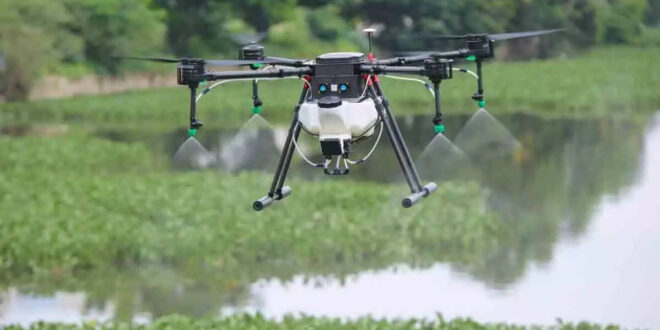By Prathiba Raju and Abhijeet Singh
New Delhi: Humanity’s oldest and deadliest vector-borne disease, malaria has continued to be a silent killer. Although there has been continuous impressive gains in reduction of the disease burden in the country, the emerging and re-emerging diseases transmitted by mosquitoes pose a growing threat. India being the most populous country in the world and having numerous unplanned urban centers influenced by factors such as temperature, rainfall along with other ecological components, drone technology is said to be one of the cost-effective solutions to control mosquito breeding.
India account’s to 66 per cent of the total cases in the South Asian continent which is considered as the malaria hotspot in the world after Africa. As per the World Health Organisation (WHO) World Malaria Report 2023 more than six lakh people lost their lives due to the seasonal disease making the number to cross pre-pandemic level.
As per experts, the aspiration goal to make India Malaria free by 2027 and eliminate the problem by 2030, needs AI-based platforms and contemporary technologies like AI with Drones and other aerial tools have been able to provide a more effective and efficient solution.
The drone technology is being used in two ways first as a means to spray the infectisides over water bodies like ponds, lakes which serve as the breeding ground for malarial mosquitoes. And second as to monitor and mapping a particular region to effectively meet the local requirements.
Talking to ETHealthworld, Prem Kumar Vislawath a Hyderabad based entrepreneur of a startup Marut Drones said, “AI-backed disease prediction systems empower local authorities with timely insights, sparing workers from hazardous chemicals and fostering safer environments. Through real-time mosquito mapping, strategic alerts, deploying customized drones and GPS-tagged fogging systems to target breeding grounds precisely.”
Regarding how profitable and scalable this profession is, Kumar said “Funding to fight malaria alone has reached US$3 billion globally in 2023. The future holds many new avenues for the use of UAVs (Unmanned Ariel Vehicles) as much of the operations are going to be replaced by UAVs.”
He also added, “Indian government prohibited the import of drones into the country, the Ministry of Civil Aviation has now made it easier for people to legally fly small drones for non-commercial purposes.”
Progressing in this direction several municipal authorities have adopted this technology in recent years, One instance is the Greater Hyderabad Municipal Corporation (GHMC) who has partnered with Kumar’s Marut Drones.
Elaborating on the efficacy of the technology Hari Chandana, Zonal Officer, GHMC said, “We have seen a minimum 60 per cent reduction in mosquito breeding after each spray. We used to spend about Rs four to five lakh per lake before, now we spend about Rs. 25000 and with increased efficiency.”
Chandra also informed that the drone technology covers a larger area in less time and it is of great help to municipal workers, who often had to get into deep lakes to spray repellents and were exposed to diseases and skin infection.
Medical professionals and experts have also acknowledged the potential of the innovation and are advocating to various authorities to use the technology in their planning and response mechanism.
Evocating his stance Dr Preetham Kumar Reddy, Pediatrician and Pediatric Intensivists, Rainbow Children’s Hospital, Secunderabad said, “Climate change can create a significant rise in vector activities. Hotter temperatures and wetter weather make mosquito larvae to multiply.”
“Harnessing drone sensors to produce predictive analysis and data regarding vector activity, can help give critical alerts on outbreaks which can help healthcare professionals maintain a quick response time. Also, it prevents manual workers from being exposed to diseases and skin infection due to the water pollution as they have to go knee deep inside dirty lakes to clean it.” Reddy added.
Sharing his opinion over the subject another expert Dr Kaushik Sarkar, Director, Institute for Health Modeling and Climate Solutions (IMACS) said, “Drones are used to help in mapping and analysing water bodies that are potential breeding grounds for mosquitoes with unprecedented accuracy. Additionally, IoT-enabled traps provide real-time entomological data, optimising vector control interventions. While traditional tools steadily aid in reducing the global malaria footprint”.
“With India’s emphasis on the digital revolution and its burgeoning startup ecosystem, the country is setting global trends in pioneering innovations in the health sector to combat diseases like malaria.” Kaushik added.
While expounding over the scope and merits of integrating AI in other areas Dr Sarkar said, “AI is becoming a game changer in mosquito control, it is being used in computer vision technology to strengthen diagnostic capabilities and it could also provide a cost-effective solution to deal with the lack of microscopists.”
Informing that navigating the challenges of public health in the 21st century, technology is emerging as a significant ally, Deepak Sahni, Founder, Healthians, said,”The potential application of drone technology for controlling mosquito-borne diseases like Malaria is a promising prospect that could revolutionize disease control. In theory, drones could access hard-to-reach areas, dispersing environmentally friendly larvicides across vast regions to effectively reduce mosquito populations. While such methods are still being explored and are yet to see widespread implementation in India due to regulatory and logistical challenges, they point to exciting possibilities for the future of public health.”
If technology, innovation and political will go hand in hand with a robust and integrated infectious disease surveillance-system, the vector-borne diseases control strategies will be the “new” beginning of the end for malaria, believe experts.
 Unmanned Aerial Vehicle The latest drone news
Unmanned Aerial Vehicle The latest drone news





